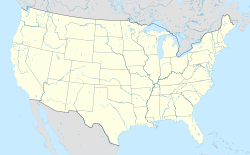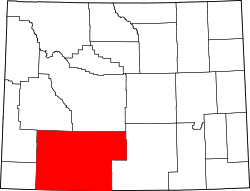| Hams Fork Crossing Site | |
|---|---|
| Location | Half mile west of Granger Stage Station |
| Coordinates | 41°35′18″N109°58′40″W / 41.5882°N 109.9778°W |
| Built | 1840s (Overland 1862) |
| Built for | Early pioneers, Overland Stage and Mail |
Hams Fork Crossing Site was a river crossing for early American pioneers in wagon trains heading west on the Overland Trail. The site is in Sweetwater County, Wyoming, west of the town of Granger, Wyoming. Ham's Fork Crossing site had good year-round water from the Ham's Fork River. The crossing was near where the Ham's Fork River flows into the Blacks Fork of the Green River. The site was also used as a route for the Overland Stage and Mail from 1862 to 1869, which ran from Denver to Salt Lake. Travelers to the Ham's Fork Crossing arrived from the Granger Stage Station just a half a mile east of the crossing. From the Ham's Fork Crossing, the Overland Trail travels west to the next stop by Church Buttes and then on to Fort Bridger. At the Granger Stage Station, the east-west Overland Trail joins the Oregon Trail coming down from the north. The Oregon Trail and Ham's Fork Crossing was used by the Pony Express from April 3, 1860 to October 26, 1861. During much of the year, the Ham's Fork Crossing could be forded by the wagons and stagecoaches. But when the river ran high, travelers had to pay to have the ferry at Ham's Fork Crossing to cross. The crossing could be over sixty feet wide and swift. Ham's Fork Crossing saw its peak use during the California gold rush, which started in 1848. The River was running high and fast in 1848/1849. The site was good for watering and feeding animals, as the banks had green grass. The banks also had alder trees and willow trees. On the north banks, a mail station and Pony Express station were built. With the completion of the first transcontinental telegraph on October 24, 1861, a telegraph station was built next to the mail station and Pony Express station. [1] [2]
With the opening of the Union Pacific Railroad's first transcontinental railroad in 1868, the wagon trains started to end. [3]


